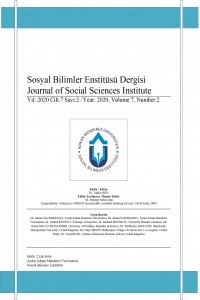Duygusal Kelime İstem Listesinin Türkçe ‘ye Çevirisi
duygusal kelime istem listesi, türkçe, geçerlilik, güvenilirlik
A Turkish Translation Of The Emotion Words Prompt List: The EWPL-TR
Turkish, reliability, validity, emotion words prompt list,
___
- BAHRICK, H. P., HALL, L. K., GOGGIN, J. P., BAHRICK, L. E., & BERGER, S. A. (1994). Fifty years of language maintenance and language dominance in bilingual Hispanic immigrants. Journal of Experimental Psychology: General, 123, 264–283.
- BUYUKOZTURK, S., CAKMAK, E. K., AKGUN, O. E., KARADENIZ, S., & DEMIREL, F. (2017). Bilimsel arastirma yöntemleri. Pegem Atif Indeksi, 1-360.
- BUYUKOZTURK, S. (2010). Sosyal Bilimler için Veri Analizi El Kitabi, Pegem Akademi Yayıncılık, Ankara.
- BUYUKOZTURK, S. (2002). Faktor Analizi: Temel kavramlar ve Olcek Gelistirmede Kullanımı. Kuram ve Uygulamada Egitim Yönetimi Dergisi, (32), 470–483.
- COKLUK, O., SEKERCİOGLU, G. ve BUYUKOZTURK, S. (2012). Sosyal bilimler icin cok degiskenli istatistik: SPSS ve lisrel uygulamalari,Pegem Akademi Yayıncılık, Ankara.
- DELGADO, P., GUERRERO, G., GOGGIN, J. P., & ELLIS, B. B.(1999). Self-assessment of linguistic skills by bilingual Hispanics. Hispanic Journal of Behavioral Sciences, 21,31–46.
- GARNEFSKİ, N., & KRAAİJ, V. (2007). The cognitive emotion regulation questionnaire: Psychometric features and prospective relationships with depression and anxiety in adults. European Journal of Psychological Assessment, 23(3), 141–149. https://doi.org/10.1027/1015-5759.23.3.141
- HARNISS, M. K., EPSTEIN, M. H., RYSER, G., & PEARSON, N. (1999). The Behavioral and Emotional Rating Scale: Convergent validity. Journal of Psychoeducational Assessment, 17(1), 4–14. Retrieved from http://proxy-remote.galib.uga.edu/login?url=http://search.ebscohost.com/login.aspx?direct=true&db=psyh&AN=1999-13280-001&site=ehost-live
- HARRISON, C. (2009). Exploring emotional web experience: more than just usability and good design. PhD Thesis, University of York, UK.
- ISEMONGER, I. & SHEPPARD, C. (2007). A construct-related validity study on a Korean version of the perceptual learning styles preference questionnaire. Educational and Psychological Measurement, 67(2), 357-368
- JORDAN, P. (1998). An introduction to Usabiliy. London: Taylor & Francis Ltd.
- KARAGOZ, Y. ve KOSTERELİOGLU, I. (2008). “İletisim becerileri degerlendirme ölceğinin faktor analizi metodu ile gelistirilmesi” Dumlupinar Universitesi Sosyal Bilimler Dergisi, 21, 81-98.
- KIM, J., & MOON, J. Y. (1998). Designing towards emotional usability in customer interfaces—trustworthiness of cyber-banking system interfaces. Interacting with Computers, 10(97), 1–29. https://doi.org/10.1016/S0953-5438(97)00037-4
- KUJALA, S., & MIRON-SHATZ, T. (2013). Emotions, experiences and usability in real-life mobile phone use. Proceedings of CHI 2013, (November), 1061–1070. https://doi.org/10.1145/2470654.2466135
- MAHLKE,S., & MINGE,M. (2008). Affect and Emotion in Human Computer Interaction, From Theory to Applications. (C. Peter & R. Beale, Eds.), Affect and Emotion in HCI, LNCS. https://doi.org/10.1007/978-3-540-85099-1_10
- MAUSS, I. B., & ROBINSON, M. D. (2009). Measures of emotion: A review. Cognition and Emotion, 23(2), 209–237. https://doi.org/10.1080/02699930802204677
- MAXWELL, B. (1996). Translation and cultural adaptation of the survey instruments. In: Martin, M. O. & Kelly, D. L. (eds.). Third International Mathematics and Science Study (TIMSS) Technical Report, Volume I: Design and Development. Chestnut Hill, MA: Boston College.
- PALEN L., BØDKER S. (2008). Affect and Emotion in Human Computer Interaction, From Theory to Applications. (C. Peter & R. Beale, Eds.), Affect and Emotion in HCI, LNCS. https://doi.org/10.1007/978-3-540-85099-1_10
- PETER, C., & BEALE, R. (2008). Affect and Emotion in Human Computer Interaction, From Theory to Applications. (C. Peter & R. Beale, Eds.), Affect and Emotion in HCI, LNCS. https://doi.org/10.1007/978-3-540-85099-1_10
- PETRIE, H., & HARRISON, C. (2009). Measuring users’ emotional reactions to websites. Proceedings of the 27th International Conference Extended Abstracts on Human Factors in Computing Systems CHI EA 09, 3847. https://doi.org/10.1145/1520340.1520582
- PETRİE, H., & PRECIOUS, J. (2010). Measuring user experience of websites: think aloud protocols and an emotion word prompt list. CHI’10 Extended Abstracts on Human Factors in …, 3673–3678. https://doi.org/10.1145/1753846.1754037
- SCHERMELLEH-ENGEL, K., MOOSBRUGGER, H., & MULLER, H. (2003). Evaluating the Fit of Structural Equation Models: Tests of Significance and Descriptive Goodness-of-Fit Measures. Methods of Psychological Research Online, 8(2), 23–74. https://doi.org/10.1002/0470010940
- SAURO, J., & LEWIS, J. R. (2012). Quantifying The User Experience. Practical Statistics for user research. Morgan Kaufmann. https://doi.org/10.1007/s13398-014-0173-7.2
- SENELER, C. (2014) The impact of learning styles and cultural background on users’ experience of websites. PhD thesis, University of York.
- TABACHNICK, B. G. ve FIDELL, L. S. (2007). Using multivariate statistics. Boston: Pearson Education Inc.
- THOMPSON, B., & LEVITOV, J. E. (1985). Using microcomputers to score and evaluate test items. Collegiate Microcomputer, 3, 163-168.
- TULLIS, T., & ALBERT, B. (2013). Measuring the User Experience: Collecting, Analyzing, and Presenting Usability Metrics: Second Edition. https://doi.org/10.1016/C2011-0-00016-9
- Yayın Aralığı: Yılda 2 Sayı
- Başlangıç: 2014
- Yayıncı: Aydın Adnan Menderes Üniversitesi
Organizasyon Yapısını Belirleyen Faktörler ve Yapının Önemi
Enerji ve Büyümenin Çevre Kirliliğine Etkisi: AB Ülkeleri İçin Panel Veri Analizi
1982 Türkiye Cumhuriyeti Anayasası’nda Cumhurbaşkanlığı’nın Denge–Denetleme Makamı Olarak Analizi
Haberin Küreselleşmesi: Kuramsal Bir Değerlendirme
Aydın İli Gözkaya Köyünde Geleneksel Halk Hukukuna Dair Örf ve Âdetler
ROC Analizi ile Zung Depresyon Ölçeği Kesme Noktalarının Belirlenmesi
Avrupa Birliği Ülkeleri ile Türkiye’deki Lojistik Köy Uygulamaları ve Uygun Kuruluş Yeri Seçimi
Türk Sinemasında Öteki Karakter: Üçüncü Sayfa Filminde Ötekilik
Keçeci-zâde İzzet Molla’nın Biyografik Eseri: Devhatü’l Mehâmid fî Tercemeti’l Vâlid
